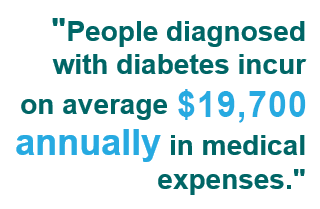How Type 2 Diabetes Affects Your Workforce
Diabetes Is Serious and Common
One in three U.S. adults has prediabetes—about 98 million people! More than 8 in 10 don’t even know they have it. Prediabetes puts a person at increased risk for type 2 diabetes, heart attack, and stroke.
Without intervention, many people with prediabetes could develop type 2 diabetes within 5 years. Type 2 diabetes puts individuals at risk of serious health problems, including:
- Heart attack
- Stroke
- Blindness
- Kidney failure
- Loss of toes, feet, or legs
Read the National Diabetes Statistics Report to learn more about the toll that diabetes is taking on the United States.
Diabetes Is Costly

Type 2 diabetes affects millions of individuals and their families, workplaces, and the U.S. health care system. In 2022, the total cost of care for people with diagnosed diabetes was $413 billion. About 1 in 4 health care dollars is spent on people with diagnosed diabetes. The majority of expenses are related to hospitalizations and medications used to treat complications of diabetes.
People diagnosed with diabetes incur on average about $19,700 annually in medical expenses. That’s about 2.6 times the medical expenses of a person without diabetes. The need to prevent type 2 diabetes has never been greater.
It’s no exaggeration; diabetes is a serious workforce issue. But you can help prevent type 2 diabetes; and it’s typically much cheaper to prevent diabetes than to treat the consequences of the disease. Learn how CDC-recognized lifestyle change programs can be an effective resource to help your employees prevent type 2 diabetes.
You can help your employees or insured members prevent type 2 diabetes by offering CDC-recognized lifestyle change programs as a covered benefit.
Reverse the Trend—CDC-Recognized Diabetes Prevention Lifestyle Change Programs
Years of research show that a year-long, structured lifestyle change intervention reduced the incidence of diabetes by 58% among adults with prediabetes and by 71% in those aged 60 years or older.
CDC-recognized diabetes prevention lifestyle change programs are based on that science, and they are part of the National Diabetes Prevention Program, or National DPP—a nationwide effort to reverse the trend of prediabetes and type 2 diabetes in the United States.
For more information on the national effort to prevent type 2 diabetes, visit What Is the National DPP?
What Makes CDC-Recognized Programs Different?

CDC-recognized lifestyle change programs use trained coaches and group support to keep participants engaged.
You can trust that your employees will get a high-quality experience that has impact, no matter which in-person or virtual CDC-recognized lifestyle change program they choose. CDC reviews each program to ensure it uses an approved curriculum and meets certain standards [PDF – 98.68KB]; CDC also monitors program progress and impact.
CDC-recognized lifestyle change programs are more than weight loss programs. The programs are tailored to people at high risk for type 2 diabetes and encourage sustained, meaningful engagement through trained lifestyle coaches and group support.
Your employees will learn to do the following:
- Make better food choices
- Fit physical activity into their schedule
- Cope with stress
- Solve problems that get in the way of their goals
In one study of a program that has served more than 26,800 participants, about 9 out of 10 participants reported increased physical activity, reduced portion sizes, and improved health after 16 weeks with the program. By the end of the year-long program, participants had lost an average of 5.7% of their body weight. Several other studies have also shown weight loss in a similar range, including an average weight loss of 4.8% among participants in an online lifestyle change program.
To learn more about the CDC-recognized lifestyle change program, visit the Lifestyle Change Program website. For technical information and resources about covering the program as a benefit, visit the National DPP Customer Service Center.
Boyle JP, Thompson TJ , Gregg EW, Barker LE, Williamson DF. (2010). Projection of the year 2050 burden of diabetes in the US adult population: dynamic modeling of incidence, mortality, and prediabetes prevalence. Population Health Metrics. Available from http://www.pophealthmetrics.com/content/8/1/29 on May 7, 2013.
CDC’s Division of Diabetes Translation. National Diabetes Surveillance System. Available from https://www.cdc.gov/diabetes/data.
Yang W, Dall TM, Halder P, Gallo P, Kowal SL, Hogan PF. Economic costs of diabetes in the U.S. in 2012. Diabetes Care 2013;36(4):1033–1046. Available from http://care.diabetesjournals.org/content/36/4/1033.
